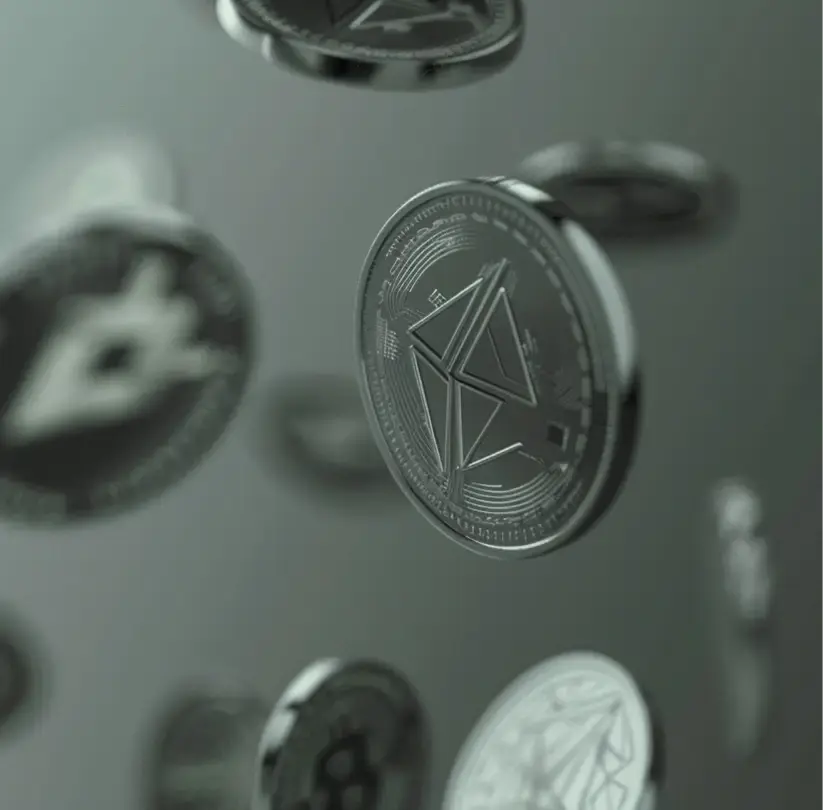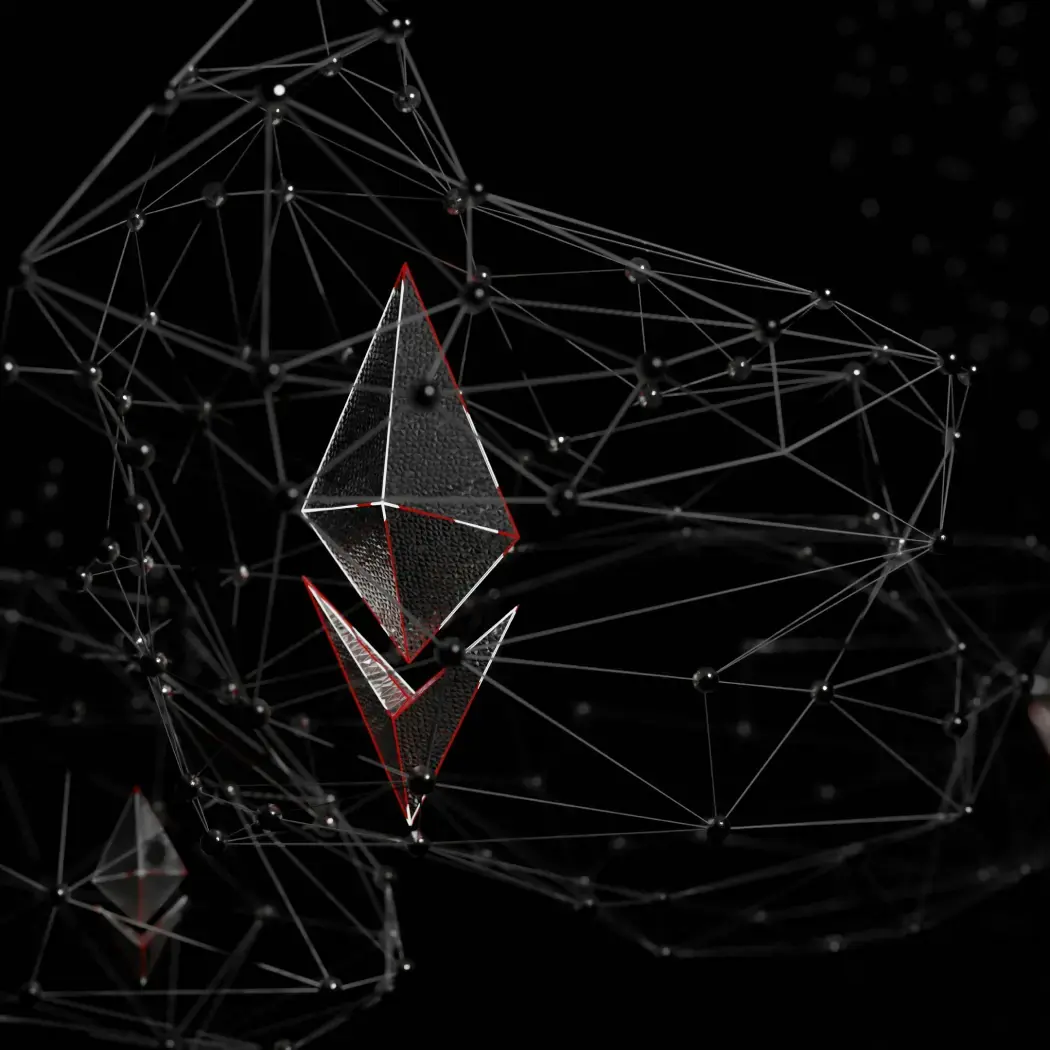Exploring Ethereum Wallets: Your Key to Accessing the Ethereum Network
Some may think that Ether (ETH) is the same thing as Bitcoin (BTC), having the same design and functions. However, if delving deeper into the topic, it appears that Ether and Ethereum wallets have a broader and more complex range of functions. Ether fuels the Ethereum network, supporting decentralized applications (DApps) and smart contracts. This makes Ethereum wallets far more versatile than simple cryptocurrency storage.
In the article, we will discuss in detail what is Ethereum wallet, how it operates, and the ETH wallets’ key components. We will also review the existing types and how to choose one that most effectively fulfills your needs. Stay until the end to learn the intricacies of the Ethereum wallet technology and how you can create one.
What is an Ethereum wallet?
An Ethereum wallet is not just a simple storage space for ETH but rather a doorway into the world of advanced blockchain technology and decentralized apps. It allows users access to a wide range of blockchain-based services such as decentralized finance (DeFi) platforms, NFTs (non-fungible tokens) marketplaces, and decentralized exchanges (DEXs).
Definition and basic concept
Before we turn to what is Ethereum wallet , it’s essential to clarify the technology behind it. Ethereum is a bunch of computers working together, thus creating one supercomputer. That powerful machine permits DApps and smart contract execution that run on its blockchain. Ethereum also allows participation in token staking, yield farming, and various decentralized autonomous organizations (DAOs).
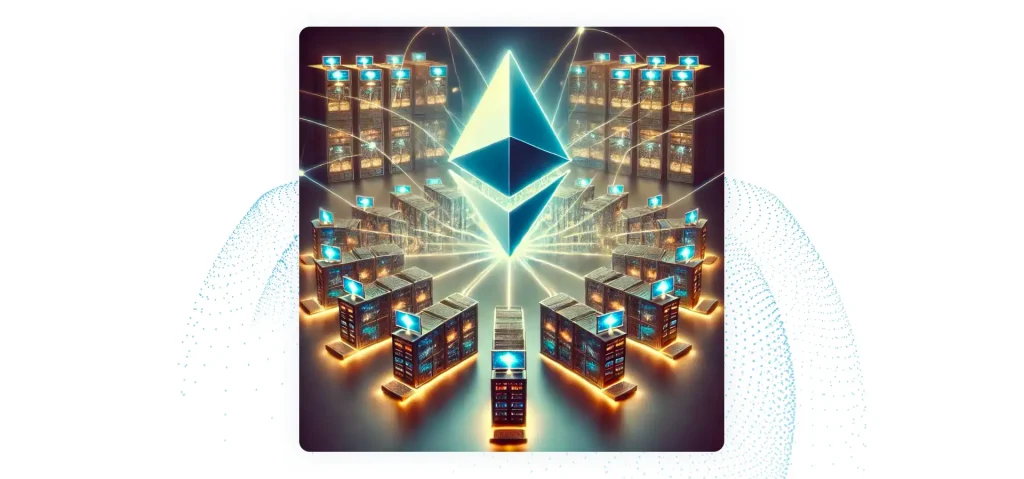
A wallet Ethereum is a necessary equipment that lets people communicate with this network. Basically, it is an intermediate between the user and his virtual accumulations, which enables them to manage their crypto. It makes it easier to send, receive, and store ETH and various tokens built on the Ethereum platform. Ethereum wallets function similarly to digital lockers, managing and storing assets safely while interacting with the larger Ethereum network.
Comparison to traditional crypto wallets
When compared to traditional crypto wallets, Ethereum wallets provide additional functionalities unique to the Ethereum blockchain. Traditional crypto wallets are often designed to store and transfer digital currencies like Bitcoin simply. Ethereum wallets, however, enable interaction with DApps and smart contracts. They allow users to engage with DeFi protocols, NFTs, and other services built on the Ethereum network.
The table below compares the functionalities of traditional cryptocurrency wallets with Ethereum-based wallets. Learn how Ethereum wallets offer more advanced features, particularly for decentralized finance and blockchain interactions.
| Area | Traditional wallets | Ethereum wallets |
|---|---|---|
| Key management | Simple key management for single-purpose private keys and basic transactions. | Handles complex key management for multiple tokens, smart contracts, and decentralized applications. |
| Asset support | Supports cryptocurrencies like Bitcoin and Litecoin, limited to coins on independent blockchains. | Accepts a large number of assets, including ETH, fungible ERC-20 tokens, and NFTs (ERC-721 tokens). |
| Transaction complexity | Operates on an unspent transaction output (UTXO) model, making transfers more straightforward. | Uses an account-based model with advanced features like multi-step transactions, gas fee management, and batching. |
| Smart contract interaction | Primarily for secure storage and basic transfers. | Enables interaction with DeFi, DAOs, and blockchain apps through smart contracts central to decentralized ecosystems. |
How Ethereum wallets work
To fully understand what is an Ethereum wallet, let’s delve into its inner operations. We broke down their cryptographic architecture and communication processes with Ethereum’s globally distributed network. Here is the result:
Ethereum network public and private keys
The two critical elements of the Ethereum wallet online are public and private keys. These cryptographic keys operate in a team. They form a robust system for security and transaction management.
The public key is an ETH wallet address on the Ethereum blockchain. It is somewhat akin to a bank account number, where others can send ETH or tokens. However, while the public key can be shared freely, the private key, presented in a 64-character hexadecimal string, must remain secret. The private key is necessary to authorize transactions, just like your bank account’s PIN. Without it, a user cannot access or transfer their funds.
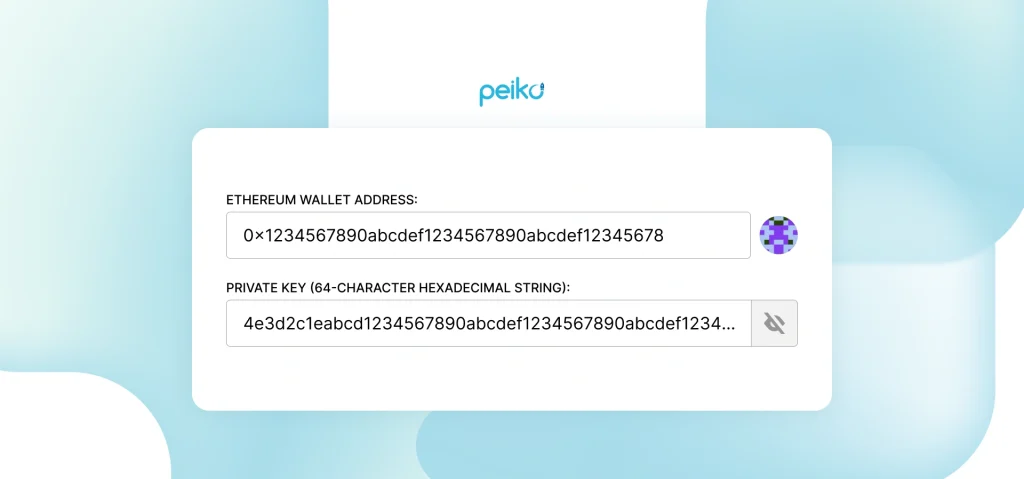
Every interaction on the Ethereum network, be it sending ETH, deploying a smart contract, or interacting with a DApp, requires signing with the private key. This cryptographic signature ensures authenticity and prevents malicious actors from tampering with transactions.
Account types
As a decentralized supercomputer, Ethereum has two primary categories of accounts: externally owned accounts (EOAs) and contract accounts.
- EOAs: Private keys control these accounts. Individuals use them to store and send ETH or tokens. EOAs can initiate transactions but cannot execute code by themselves. Most wallet addresses are EOAs, and users sign transactions with their private keys to move funds or interact with smart contracts.
- Contract accounts: These contracts, on the other hand, are governed by code. Created through a contract deployment, they don’t have private keys. Instead, they follow predefined rules set within the smart contract. Contract accounts are only able to run their code when triggered by a transaction, which can come from an externally owned account (EOA) or from another smart contract.
The key difference is that EOAs are controlled by humans, while smart contract logic manages contract accounts. EOAs initiate actions, while contract accounts react to these actions.
Interaction with the Ethereum blockchain
Interaction with the Ethereum blockchain occurs via cryptographically signed transactions from an EOA. They are distinct from contract accounts that cannot start transactions by themselves. Each transaction contains:
- The sender’s and recipient’s addresses.
- The quantity of tokens or ETH.
- A nonce (a unique, sequential number associated with each transaction sent from a particular Ethereum account) to ensure uniqueness and prevent replay attacks.
- A gas limit (the maximum amount of computational work the sender is prepared to pay)
- A gas price (The amount of ETH a sender is willing to pay per unit of gas, expressed in Gwei)
The optional data field is vital for smart contract interactions, encoding function calls, and parameters. Once the sender’s private key is signed, the transaction is validated and processed by validators or miners, depending on the agreement.
The Ethereum Virtual Machine (EVM) executes the transaction based on the provided data. It updates account balances and contract storage or emits events as necessary. Transactions that encounter errors (e.g., running out of gas) are reverted, ensuring no partial changes are applied.
Types of Ethereum wallets
Like many blockchain networks, Ethereum is compatible with various kinds of cryptocurrency wallets. They come in various forms, offering unique features and serving different needs. When choosing the best ETH wallet for your needs, you’ll face a choice of three Ethereum wallets types.
Hardware wallets
They are extremely safe from hackers since private keys are kept offline. These wallets generate and store private keys inside the device’s hardware. During a transaction, the hardware wallet signs it within the device and then transfers the signed transaction to a connected app or computer, which sends it to the Ethereum network. This keeps the private key isolated from internet-connected devices, ensuring higher security.
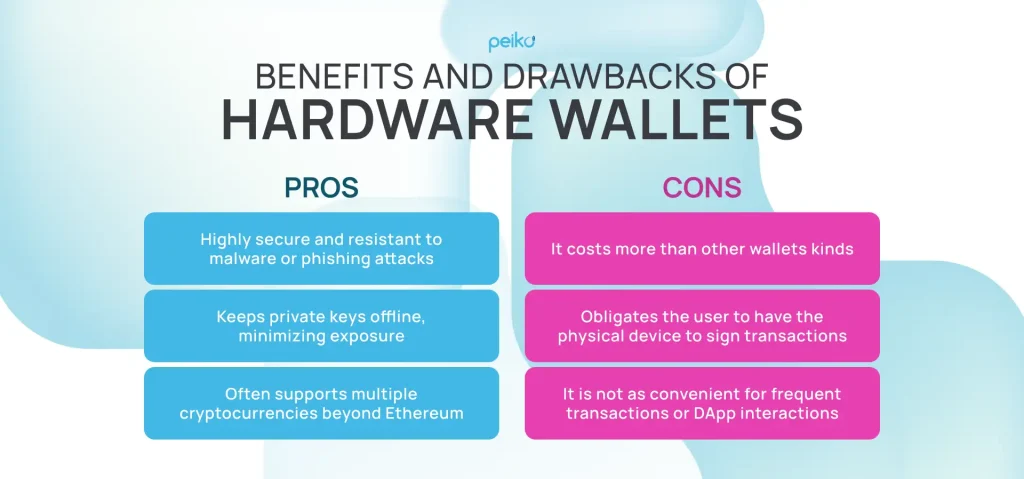
Software wallets (desktop, mobile, web-based)
These wallets run as apps on desktops, mobile devices, or web platforms, storing private keys in encrypted files on the device. The wallets, such as an Ethereum desktop wallet, provide an easy way to interact with DApps. They also support various Ethereum tokens like ERC-20 and ERC-721. Software wallets come in different forms: desktop, mobile, and web-based wallets. Each offers a different balance of accessibility and security based on user preferences.
Desktop wallets
Installed on computers and provides complete control of private keys locally. This setup offers greater security compared to Ethereum wallet online, as private keys are never exposed to the web. They support full-node clients like Geth or Parity, which can verify and store the entire blockchain. Examples include MetaMask (when used as a browser extension) and MyEtherWallet’s (MEW) desktop version.
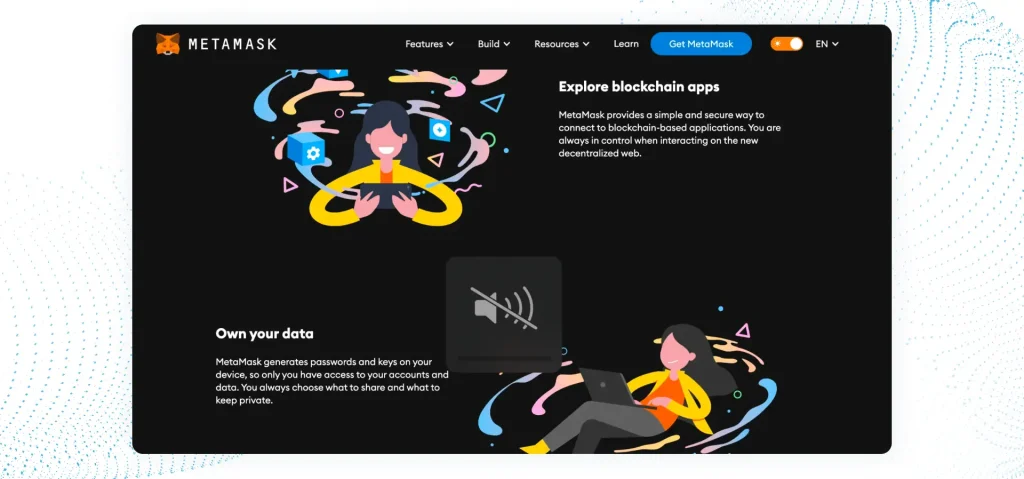
Mobile wallets
Mobile wallets are designed for convenience, offering quick access to Ethereum and other tokens. Smartphone apps like Trust Wallet or MetaMask’s mobile app allow for on-the-go management of Ethereum and DApp interactions. They frequently have functions like quick transactions via QR code scanning and direct interaction with DApps through integrated browsers.
Web-based wallets
Web-based wallets are accessible directly through browsers. These wallets, like the web version of MetaMask, are hosted on external servers. It implies the advantage of not requiring any local software installation. To mitigate risks, most web wallets offer options to establish a connection to hardware wallets like Ledger or Trezor. It ensures safer transaction signing without exposing the private key online.
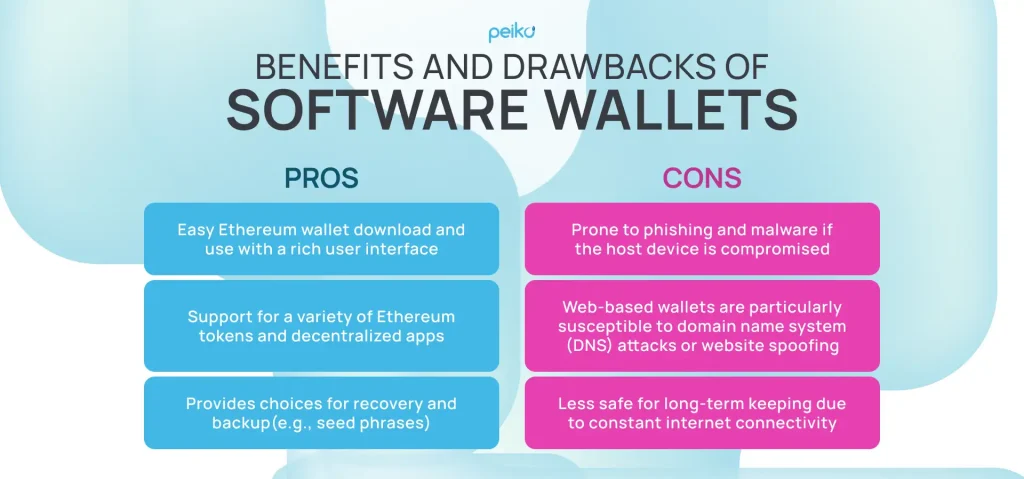
Paper wallets
The most basic form of Ethereum wallets. They consist of a physical document, typically a piece of paper, that contains both the public address and the private key in text or QR code format. Users can create a paper wallet by using offline tools to generate a new Ethereum address and print out the details. This type of wallet is considered an Ethereum cold wallet, as the private keys are completely offline and cannot be hacked unless someone gains physical access to the document.
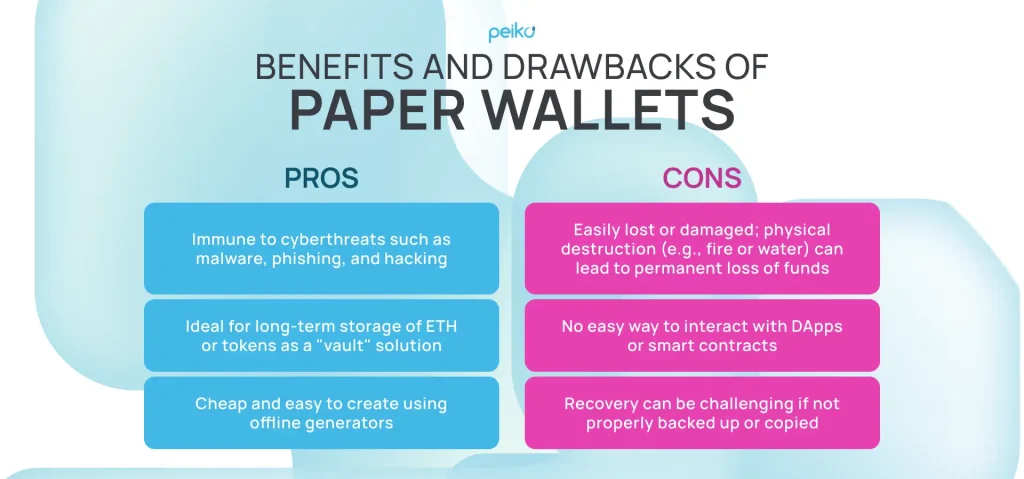
Key features of Ethereum wallets
ETH wallets provide access to the huge Ethereum chain, the world of decentralized applications. Let’s learn what is Ethereum chain’s uniqueness, and how its features contribute to it.
Storing and managing ETH and ERC-20 tokens
Whether it’s a cold wallet (offline storage) for extra security or a hot wallet (online storage) for quick access, Ethereum wallets offer flexible storage options for various tokens. Apart from ETH, it supports many assets. Firstly, it supports ERC-20 tokens, which represent fungible digital assets (e.g., stablecoins like USDC and governance tokens like UNI). Secondly, it allows the management of ERC-721 tokens, which are used for unique, non-fungible assets like NFTs (e.g., digital art and collectibles).
Sending and receiving transactions
Within the Ethereum chain, each wallet owner has a personal ETH wallet address, which enables him to exchange crypto with other Ethereum users. To perform a cryptographic transaction, the user generates a unique transaction message. It contains the address of the recipient, the quantity of ETH or tokens to be sent, and the gas fee (the computational cost of the transaction). Users can monitor transaction statuses, view balances, and check transaction histories directly from their wallets.
Interacting with decentralized applications
DApps are decentralized applications that don’t operate on a single, centralized server but rather on a blockchain network. Users can interact with wallets like MetaMask by connecting their wallets. Thus, they can participate in DeFi platforms, crypto games, NFT marketplaces, or even voting in governance systems. Plus, the Ethereum wallets communicate with smart contracts on the Ethereum blockchain, enabling complex operations like staking tokens or providing liquidity.
Getting started with your first Ethereum wallet
Now that you have a clear image of what is ETH wallet, we propose to delve into how to
create Ethereum wallet so it satisfies your needs. Firstly, we’ll explain how to select a suitable wallet, then turn to the creation steps and some tips for beginners.
Choosing the right Ethereum wallet
Why is it important to delve into the peculiarities of each Ethereum wallet? Everyone has a unique request, and to satisfy it, it is essential to explore which wallet type can best do this.
For instance, hardware wallets suit serious investors and users who place security above ease of use. They are also the right choice when storing large amounts of cryptocurrency frequently.
The most convenient option for frequent transactions and day-to-day use is a software wallet, though they are not as secure as hardware wallets. They are ideal for users who need easy access to their funds and want to engage with DeFi platforms, NFTs, and other Ethereum-based services.
Paper wallet is the best Ethereum wallet for users who store Ethereum in a cold wallet and want to avoid the cost of a hardware wallet. Or those who wish to gift cryptocurrency. It’s ideal for long-term storage but not for active trading or regular use.
Step-by-step guide for setting up a wallet
Setting up a wallet is required to manage and secure your cryptocurrency. This manual takes you through the essential steps. Whether you choose a hardware, software, or paper wallet, following these steps will help keep your assets safe.
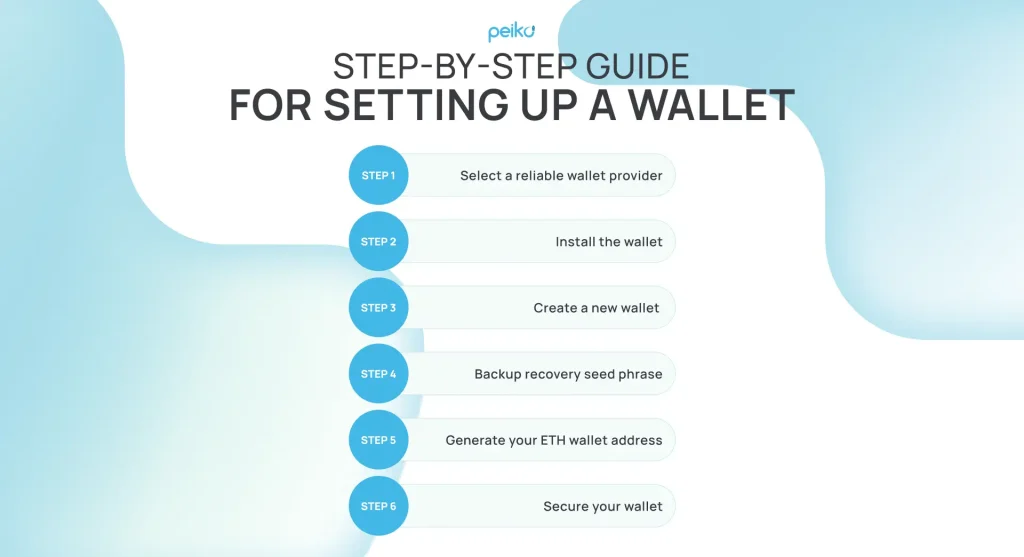
Step 1: Select a reliable wallet provider
Hardware wallets are great for long-term storage because they stay offline. To be safe, buy from official retailers and follow setup instructions. Software wallets, ideal for frequent transactions, should only be downloaded from reliable websites. Paper wallets involve creating and printing keys offline for extra security.
Step 2: Install the wallet
Hardware wallets connect via USB or Bluetooth and need an app to manage funds. Apps or browser extensions serve as software wallets that you install. Paper wallets involve generating and printing keys offline to protect them from internet dangers.
Step 3: Create a new wallet
Once you’ve accessed your wallet (downloaded or generated), the first thing to do is create a new one. You can choose to create a new wallet or restore using an existing recovery phrase. For new wallets, you’ll generate a public and private key pair.
Step 4: Backup recovery seed phrase
Most wallets generate a recovery phrase (usually 12, 18, or 24 words) that you must write down and store safely. Write down the phrase shown on the screen. Store it securely and offline (on paper or a physical medium) in multiple safe locations. Never share it with others or store it online – this is the key to your funds.
Step 5: Generate your ETH wallet address.
After the setup, your wallet will generate a unique address. Your wallet address is available via the wallet interface. Use this address to receive ETH or interact with DApps.
Step 6: Secure your wallet
Each wallet type requires specific steps to stay secure. For save operations, unplug hardware wallets when not in use. Add two-factor authentication (2FA) to software wallets and use a secure device. To keep them safe from harm, paper wallets should be kept in a fire and waterproof area.
Security best practices
After the Ethereum wallet download and set up, one had to ensure the best possible crypto safeguarding.
The risks associated with Ethereum wallets, especially online ones, revolve around their vulnerability to hacking and phishing attacks. An Ethereum wallet online, also known as a hot wallet, is connected to the internet, making it a prime target for cybercriminals. Hackers may attempt to exploit vulnerabilities in the device, steal private keys, or trick users into revealing sensitive information through phishing scams.
Consider the best ETH wallet security practices to save your assets:
- Turn on 2FA: Make sure to activate 2FA. It adds an extra step to log in that hackers can’t easily bypass.
- Backup your wallet: Ensure a regular back up of your wallet. Losing access means losing your crypto, and it cannot be restored without a backup.
- Provide real privacy for your private keys: Keep your private keys hidden and safe since they are the master keys to your crypto.
- Keep wallet software updated: Each update adds security improvements that protect your assets from new, emerging threats.
- Encrypt the wallet: Encryption locks your wallet with a strong password, raising the security ante and keeping it safe from hackers.
The future of Ethereum wallets
The more people know what is Ethereum wallets, the more use the Ethereum chain will acquire. Today, there are more than 120 million Ethereum tokens in global crypto circulation, with 119 million in 2021. This is already ten times more than Bitcoin’s current circulation.
The growing popularity significantly impacts its buying price. As Ethereum matures, industry experts predict that ETH could surpass $10,000 per coin by the decade’s end. With the growing ecosystem of DApps, NFTs, and the expanding use of Ethereum smart contracts, this price point seems achievable. By 2040, Ethereum’s price could double, driven by further network upgrades like Ethereum 2.0, increased staking participation, and greater institutional interest.
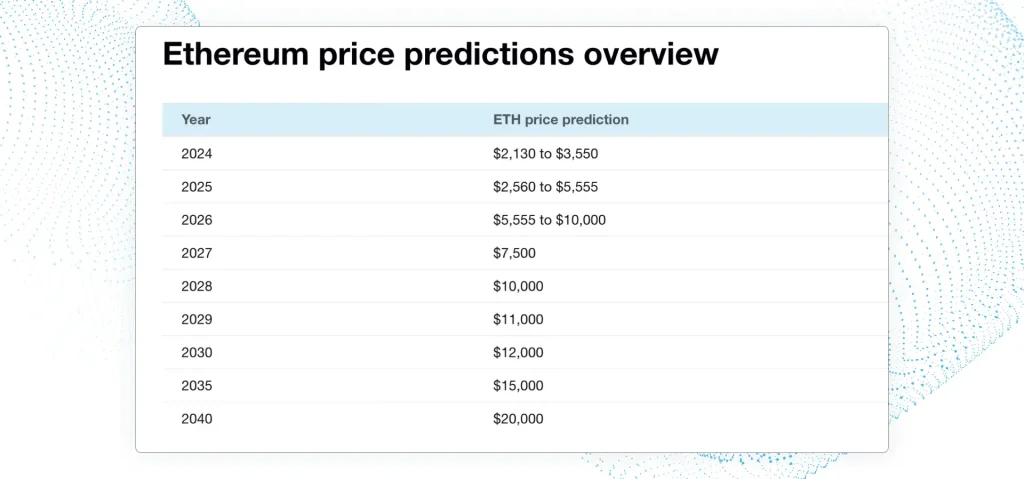
The best Ethereum wallets, such as MetaMask, Trust Wallet, and Ledger, are upgrading with better security, easier interfaces, and multi-chain support. These changes make it simpler for anyone to install ETH wallets to swap tokens, stake, and participate in DeFi, helping more people get involved.
Choose Peiko as your best blockchain developer
Apart from discussing what is ETH wallets, the Peiko team can also create ETH wallet for you. We are proven experts in blockchain development and have numerous successful case studies. We’d now like to present you one of our most outstanding cases.
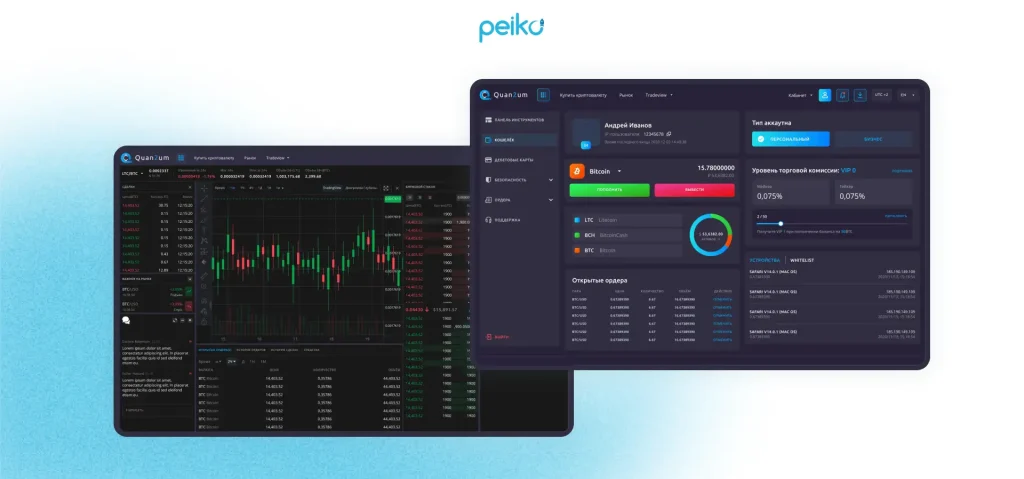
Peiko’s team added immense value to Quan2um by building a secure and efficient cryptocurrency exchange tailored to modern traders’ and investors’ needs. Our team designed a real-time marketplace with advanced price-matching algorithms and high-level security that complies with European standards. They managed market liquidity and ensured user-friendly controls in the admin panel. Peiko also promoted BTCA (Quan2um’s native coin), enabling users to generate passive income and enhancing the platform’s investment potential.
The platform offers sophisticated features like a referral program and a multi-level commission system, driving user engagement and community expansion. Cold and hot wallet integration protects user assets. Advanced functions such as trade order matching and BTCA master node investments highlight Peiko’s technical expertise and focus on delivering user-centric solutions.
With Peiko, clients receive solutions that combine technical excellence and user understanding. Our ability to create secure, high-performance cryptocurrency platforms ensures they meet the demands of the evolving digital economy.
Conclusion
Ethereum wallets are not merely storage solutions for Ether but essential tools for interacting with the vast ecosystem of decentralized applications, smart contracts, and digital assets on the Ethereum network.
By 2040, Ethereum will greatly power a global digital economy by supporting digital identities, tokenized assets, and DApps. Ethereum wallets will likely evolve beyond storing cryptocurrency. They will act as identity managers, helping users control their digital lives and interact with DAOs. Users can even vote on governance matters.
The best wallets will become essential for managing identities, finances, and ownership. They’ll act as passports to the decentralized world. As wallets improve, they’ll lower barriers for new users, making it easier to join the ecosystem and driving Ethereum’s growth and adoption.
Contact us if you need Ethereum wallet development for your next blockchain project. Peiko is ready to deliver tailored solutions that combine security, flexibility, and scalability. Whether you’re building my Ethereum wallet for personal use or a custom wallet for your business, our team has the expertise to craft a secure and user-friendly wallet.
No comments yet. Be the first to comment!





